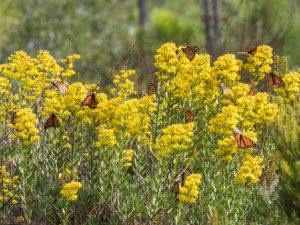Ryan Singer
Butterflies are essential insects as both predator and prey within the food chain. Bats and birds rely on the adult butterflies as well as caterpillars as a food source. Butterflies eat a variety of plants and nectar. Besides being food for other animals, the butterfly eats a variety of insects. As a caterpillar, they eat aphids. They are important components of a thriving ecosystem.
Pollinating flowers, especially red or yellow ones with a strong scent, is an important role that butterflies play within the ecosystem. Several plant species rely on the butterfly for pollination, like milkweed. Pollen collects on the body as the butterfly is feeding on nectar and is transferred from plant to plant as it moves from flower to flower.

Scientists monitor butterflies as indicators of climate change. Certain butterflies have shifted their distribution further north and to higher elevations as a result of an increase in temperature. Declining populations as a result of climate change, affects birds, other insects, and small mammals when they lose their food source and must eat less desirable or less available species. In addition to indicating climate change, butterflies are sensitive to habitat destruction and can be an indicator of the future effects of habitat loss on other animals.
We as a society can accommodate the butterfly’s habitat loss by creating gardens within our own yards to attract butterflies. Providing sunny areas for butterflies to warm up and bask and a shallow water source such as a birdbath will help combat the loss of natural habitats. The following list of plants is an excellent selection of butterfly attractors.
Butterfly bush, Phlox, Bluestar, Coneflower, Pot Marigolds, Black-Eyed Susan, Blazing Star, Heliotrope, Lavender, Swamp Milkweed, Butterfly Weed, Flossflower, Chocolate Cosmos, Agapanthus, Aster, Salvia, Sea Holly, Hollyhocks, Sunflower, Sedum, Goldenrod, Allium, Joe-Pye Weed, Cardinal Flower, Penta, and Lantana.
Planting a variety of these in several locations throughout your yard will encourage butterflies to move in permanently. They need nectar as well as warmth and room to fly. Research the planting zone you live in and use native species that provide food for the caterpillar stage of its life cycle. If you do not have a yard, window boxes or potted plants on a patio will still provide butterflies a place to thrive. Even leaving fallen fruit on the ground or on top of the compost heap will provide butterflies with the necessary sugar they crave in late summer.
Leave an area of the yard “wild” to provide larvae with the grasses and weeds they need to grow. Furthermore, avoid pesticides that are harmful to butterflies. Plants bought from the garden center may also have been treated. Try to buy organic plants instead. Create a shelter for butterflies by planting larger leaf species such as trees and shrubs. When the weather turns from sunny to stormy, they will have a place to hide.
Landscaping with native plants is a sustainable practice that requires fewer resources. Native plants are better adapted to their climate and are natural hosts to butterflies. Butterfly gardens provide colorful flowers that draw the interest of humans which result is a greater awareness of the environment and a better understanding of our role in preserving natural habitats.
Sources:
https://sciencing.com/plants-animals-germany-6775765.html
https://www.hgtv.com/outdoors/flowers-and-plants/flowers/butterfly-garden-flowers-pictures
https://www.nhm.ac.uk/discover/gardeners-guide-to-butterflies.html
https://homeguides.sfgate.com/benefits-butterfly-gardens-environment-50693.html